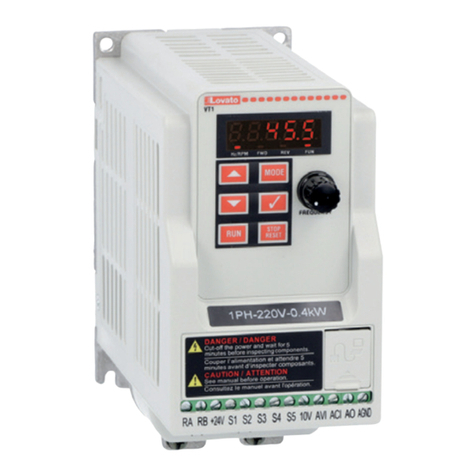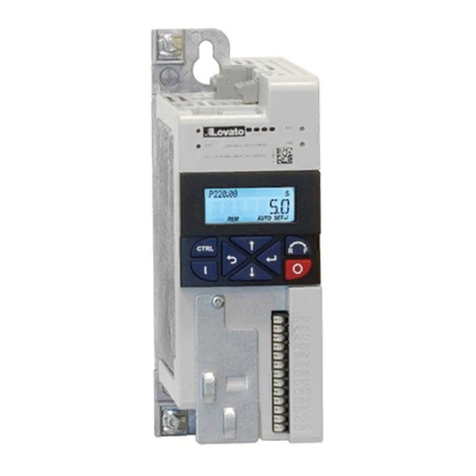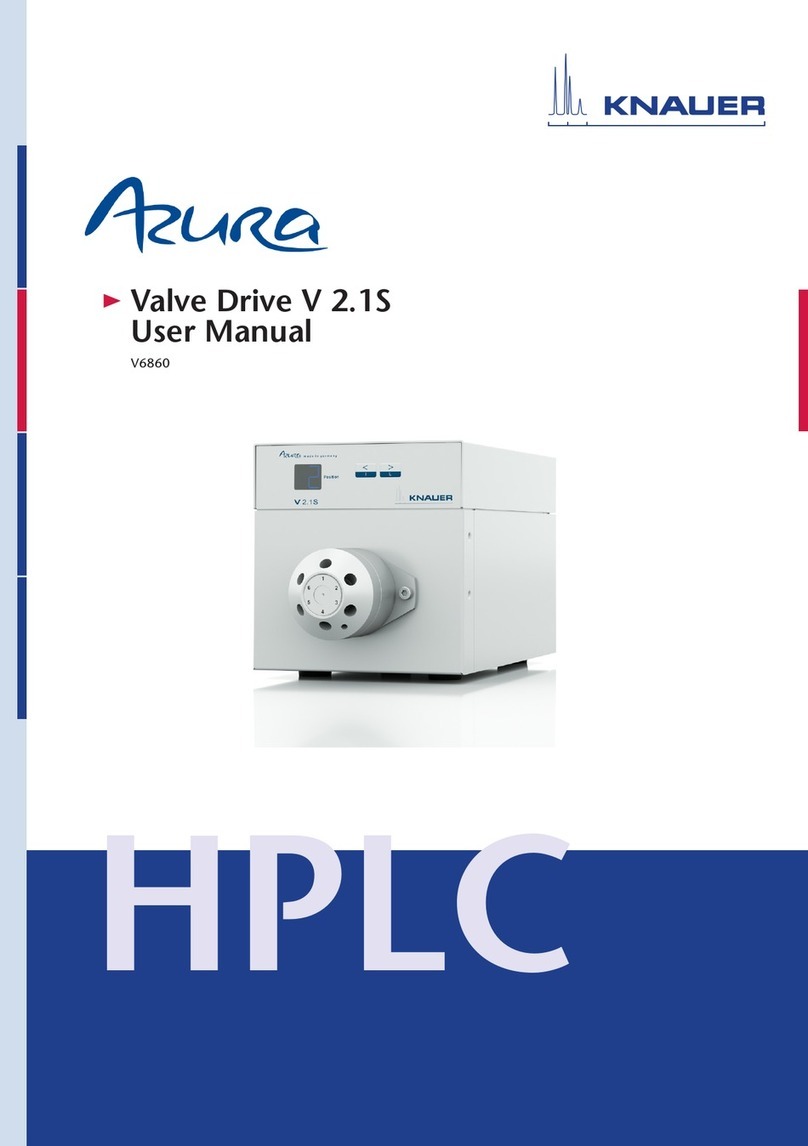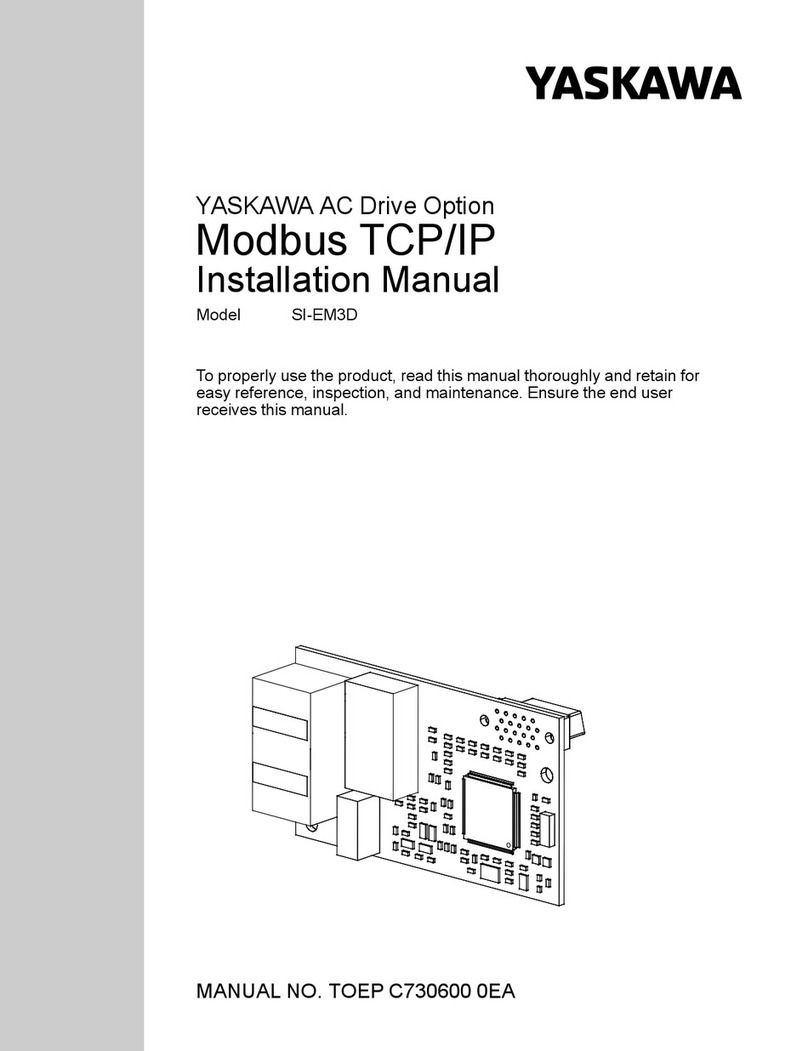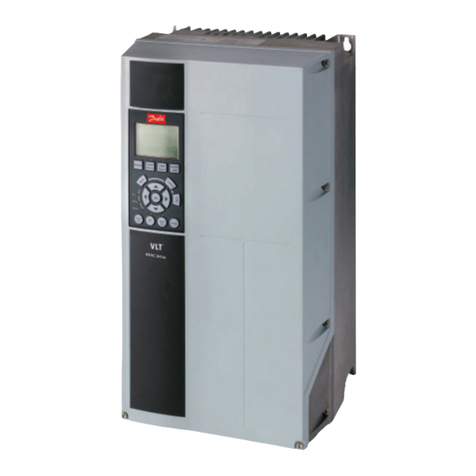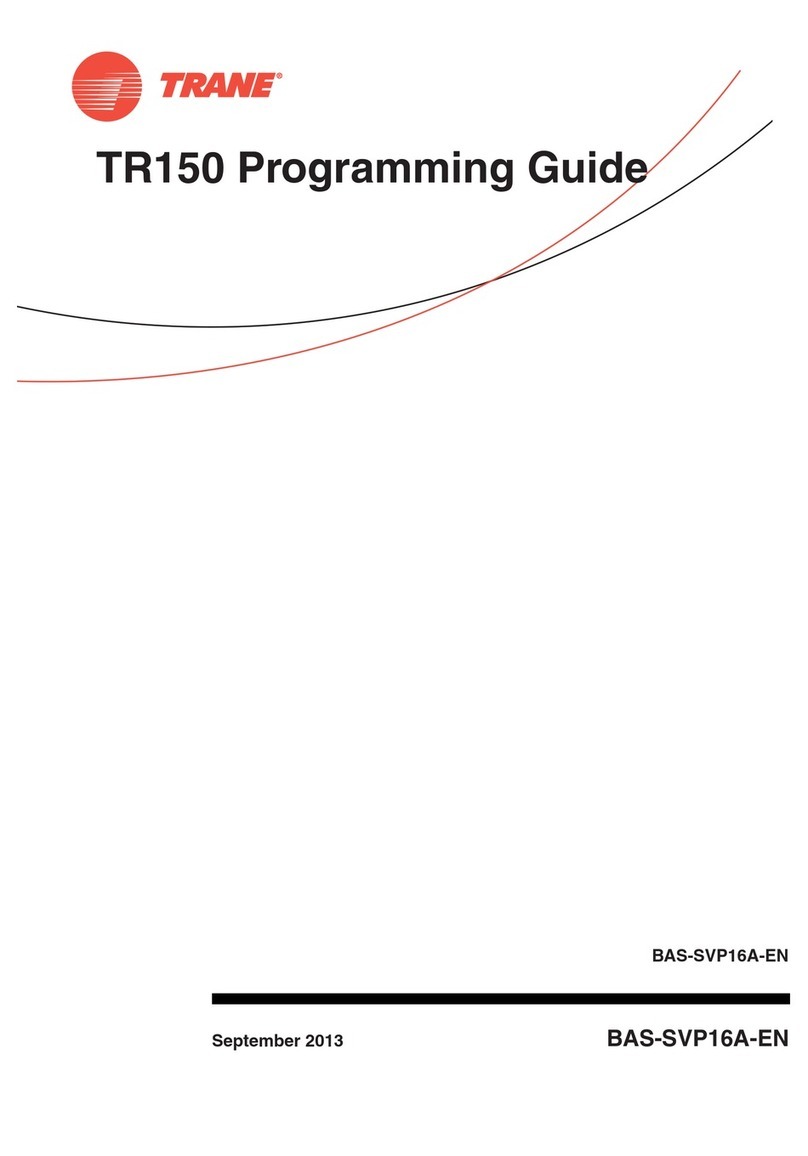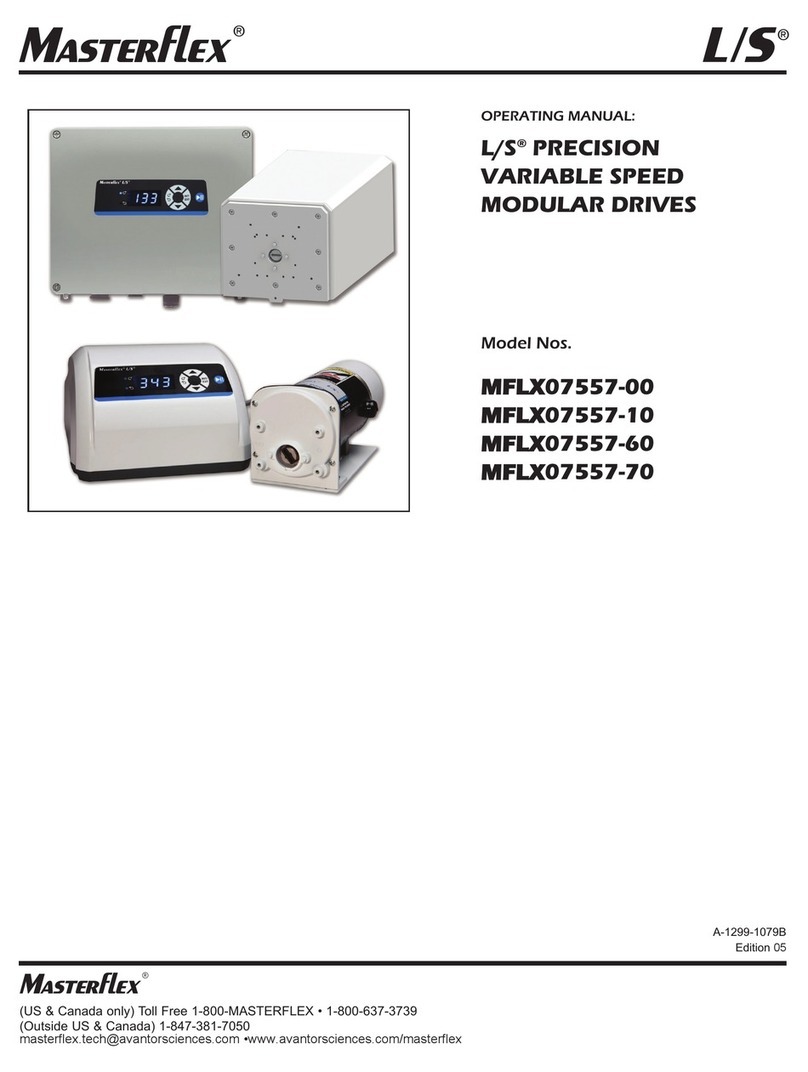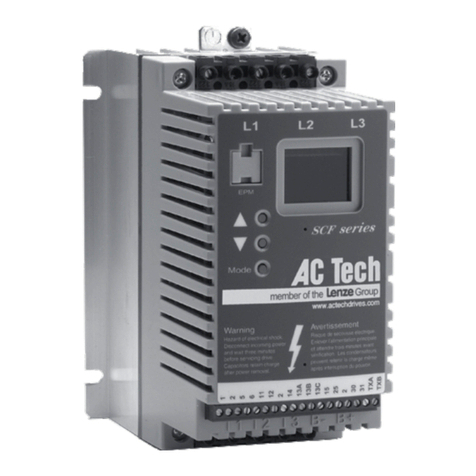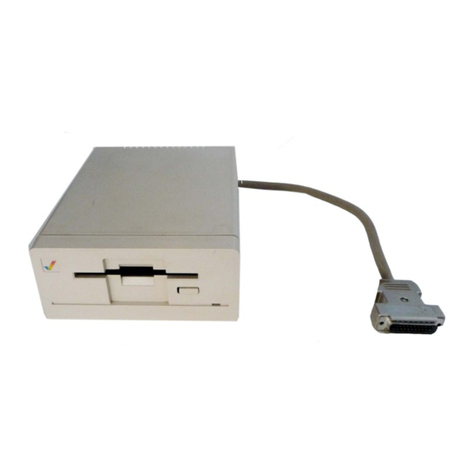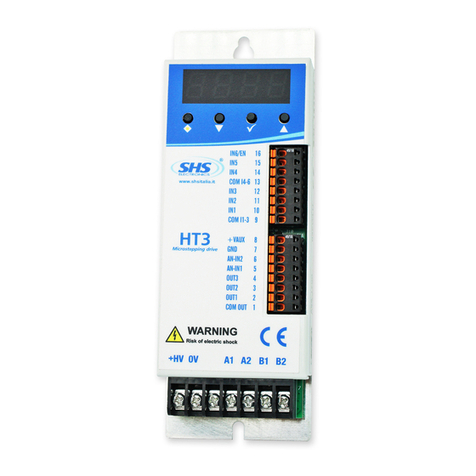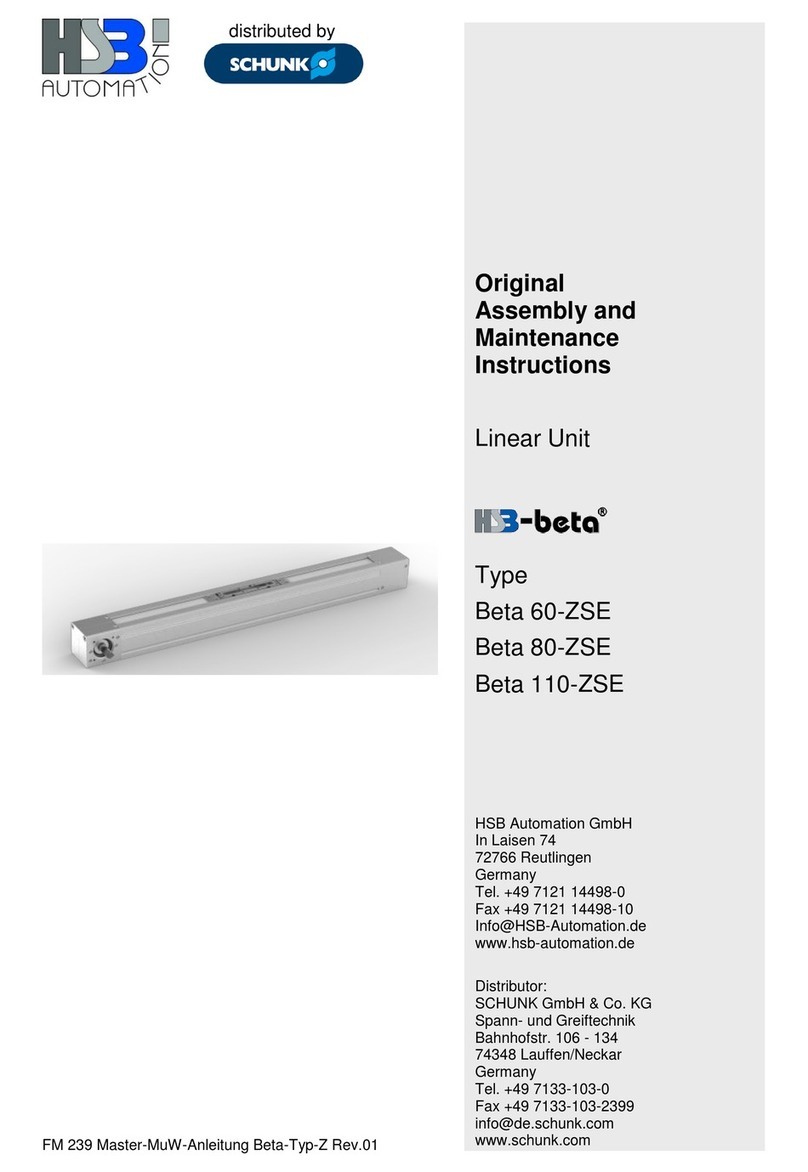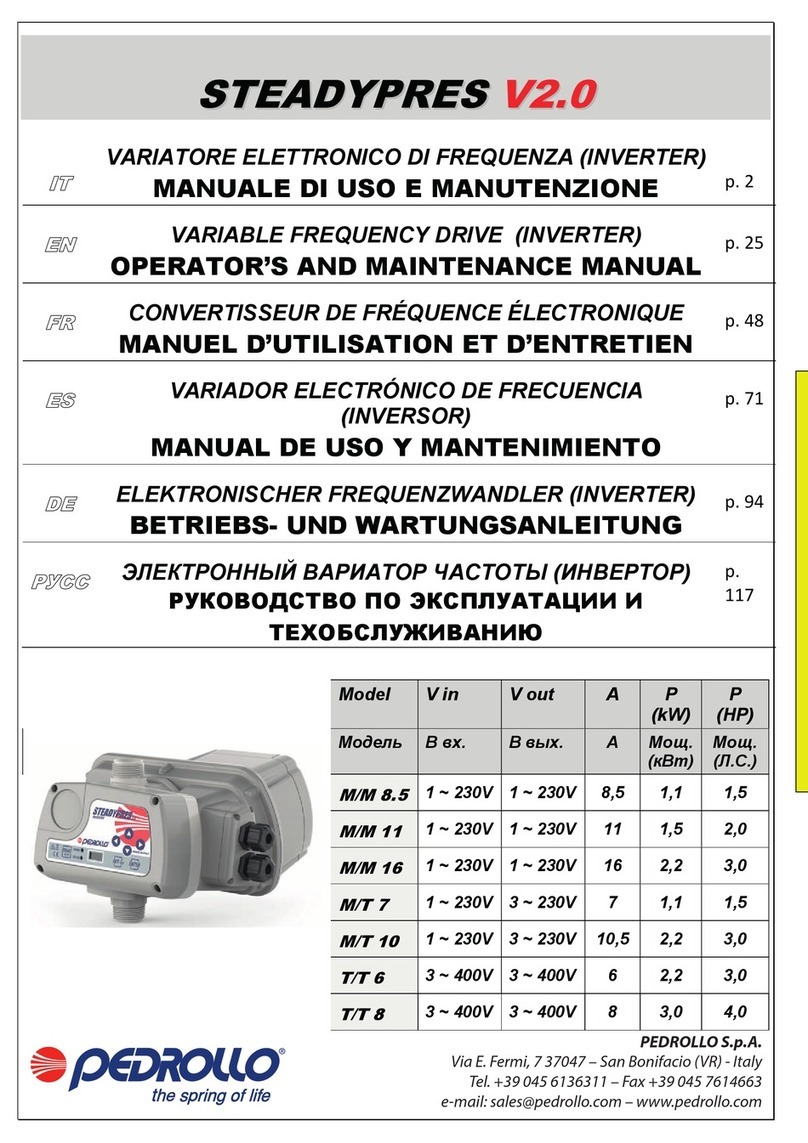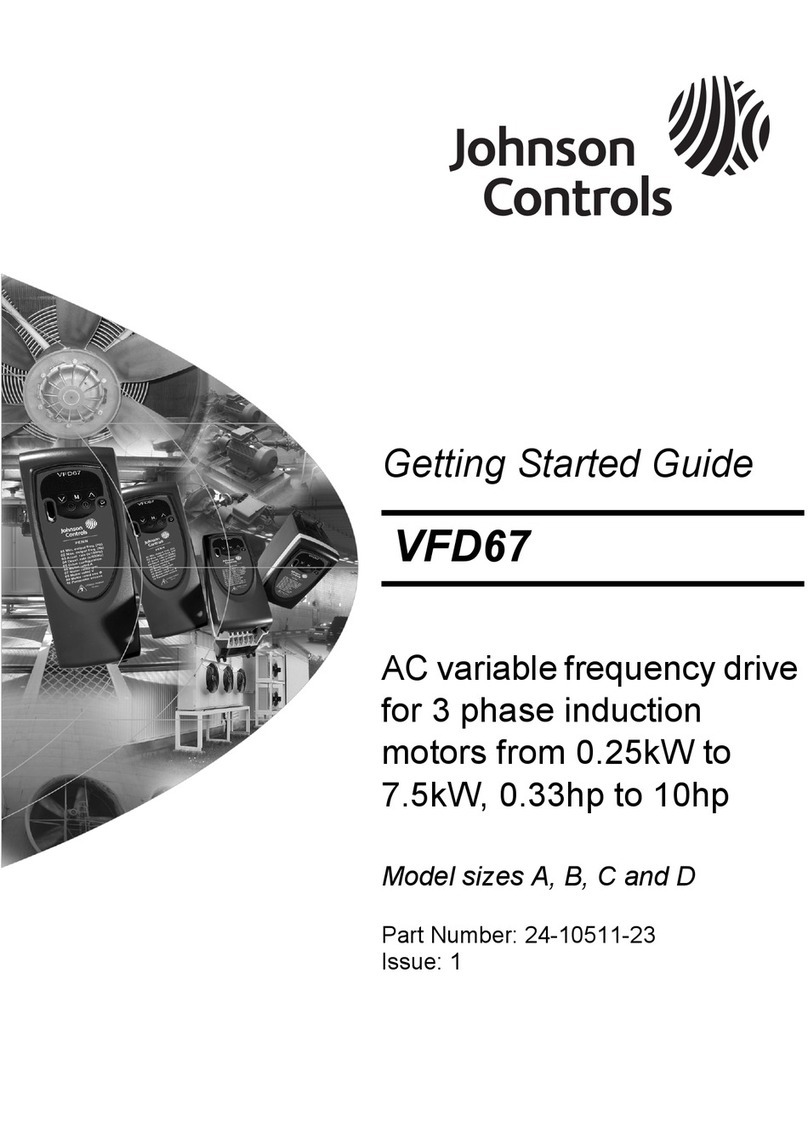LOVATO ELECTRIC VLB3 Series User manual

I521 GB 01 19
1
VLB3…
QUICK GUIDE FOR THE CONFIGURATION OF VARIABLE SPEED
DRIVES
GB
LOVATO ELECTRIC S.P.A.
24020 GORLE (BERGAMO) ITALIA
VIA DON E. MAZZA, 12
TEL. 035 4282111
FAX (Nazionale): 035 4282200
FAX (International): +39 035 4282400
E-mail info@
L
ovato
E
lectric.com
Web www.
L
ovato
E
lectric.com
SUMMARY PAGE
1. Navigation in the menu .............................................................................................................................................................................................................................................................................................. 2
2. Reset parameters to default ...................................................................................................................................................................................................................................................................................... 3
3. Command the run/stop of the motor .......................................................................................................................................................................................................................................................................... 4
3.1 2-wires control from the flexible I/O terminal block ........................................................................................................................................................................................................................................... 4
3.2 From keypad ....................................................................................................................................................................................................................................................................................................... 4
3.3 3-wires control from flexible I/O terminal block ................................................................................................................................................................................................................................................. 4
4. Frequency adjustment ................................................................................................................................................................................................................................................................................................ 5
4.1 From keypad ....................................................................................................................................................................................................................................................................................................... 5
4.2 From external potentiometer .............................................................................................................................................................................................................................................................................. 5
4.3 From analog input signal type 0-10V ................................................................................................................................................................................................................................................................. 5
4.4 From analog input signal type 4-20mA .............................................................................................................................................................................................................................................................. 6
4.5 With preset frequency setpoints ......................................................................................................................................................................................................................................................................... 6
4.6 From motor potentiometer (MOP) ...................................................................................................................................................................................................................................................................... 7
4.7 With Modbus communication protocol .............................................................................................................................................................................................................................................................. 7
4.8 PID Control - Setpoint adjusted with keypad and feedback signal type 0-10V ................................................................................................................................................................................................... 7
4.9 PID Control - Setpoint adjusted with keypad and feedback signal type 4-20mA ............................................................................................................................................................................................... 7
5. Motor parameters ....................................................................................................................................................................................................................................................................................................... 8
6. Additional functions ................................................................................................................................................................................................................................................................................................... 9
6.1 Configuration of the relay output function .......................................................................................................................................................................................................................................................... 9
6.2 Configuration of the DO1 digital output function ................................................................................................................................................................................................................................................ 9
6.3 Configuration of the AO1 analog output function ............................................................................................................................................................................................................................................... 10
6.4 Enable of the start at power-up function (auto-restart) ...................................................................................................................................................................................................................................... 10
6.5 Command of digital inputs from PLC ................................................................................................................................................................................................................................................................. 11
6.6 Configuration of the automatic (PID) / manual (frequency regulation) mode .................................................................................................................................................................................................... 11
6.7 Control of the variable speed drive by EXCRDU1 remote keypad ....................................................................................................................................................................................................................... 13
6.8 Common error codes ......................................................................................................................................................................................................................................................................................... 14
HOW DO YOU WANT TO COMMAND
THE RUN AND STOP OF THE MOTOR?
See chapter 3
HOW DO YOU WANT TO ADJUST
THE FREQUENCY OF THE MOTOR?
See chapter 4
SET THE MOTOR PARAMETERS
See chapter 5
LEARN HOW TO NAVIGATE THE MENU
See chapter 1
RESET PARAMETERS TO
DEFAULT
See chapter 2
CONFIGURE ADDITIONAL FUNCTIONS
See chapter 6
Steps to follow for the configuration of the variable speed drive:

I521 GB 01 19
2
1. NAVIGATION IN THE MENU AND LOADING DEFAULT SETTINGS
Function of the keypad keys
Navigate: select group/parameter.
Change parameter setting.
Pressed shortly: enter in the sub parameter level.
Keep pressed for more than 3 sec to save parameter
settings in the memory.
Exit from the menu/parameter
Stop motor
Run motor
Activate full keypad control
(available from firmware version 4.1)
Reversal of rotation direction
(available from firmware version 4.1)
Example of navigation in the menu of the VSD and modification of a parameter.
Back to the previous level
Back to the previous level
Back to the previous level
Back to the previous level
without saving
Enter in parametrisation mode
Enter in the group
Confirm the parameter to modify
Confirm the sub-parameter
Confirm the modify
Keep pressed for 3 seconds to save all
the parameters modified.
Select the group
Select the parameter
Select the sub-parameter
Modify the value of the parameter

I521 GB 01 19
3
2. RESET PARAMETERS TO DEFAULT
To reset all the parameters to factory settings follow this procedure:
– Set the parameter P700.01 = 1 (load default settings)
– Press the button several times to exit from the programming menu until it appears the text STOP.
– Keep pressed the button for 3 seconds until it appears the text “P.SAVED”, which indicates the saving of the parameters.

I521 GB 01 19
4
3. COMMAND THE RUN/STOP OF THE MOTOR
3.1 2-wires control from the flexible I/O terminal block
3.2 From keypad
Parameter Function Setting Description
P400.01 VSD enable 1 VSD always enabled (default setting)
P400.02 Run/stop command 11 Run/stop command from digital input DI1 (connected between terminals DI1-24V)
NO
COM
NC
24E
GND
AI1
AI2
AO1
10V
24V
DI1
DI2
DI3
DI4
DI5
DO1
GND
3.3 3-wires control from flexible I/O terminal block
Parameter Function Setting Description
P400.01 VSD enable 1 VSD always enabled (default setting)
P400.02 Run/stop command 11 Run/stop command is given by DI1 (NC contact). It serves as start enable for the
function “Start forward” (P400.06).
P400.06 Start forward command 12 Start forward command from DI2 (NO contact)
NO
COM
NC
24E
GND
AI1
AI2
AO1
10V
24V
DI1
DI2
DI3
DI4
DI5
DO1
GND
Parameter Function Setting Description
P400.01 VSD enable 1 VSD always enabled (default setting)
P400.12 Keypad control 1 Activate keypad as control source
P400.02 Run/stop command 1 Constant true (run/stop command is managed by keypad)
Start
Stop
Stop
24E
24E
Run/Stop
Start forward

I521 GB 01 19
5
4. FREQUENCY ADJUSTMENT
4.1 From keypad
Increase the frequency
Decrease the frequency
Parameter Function Setting Description
P201.01 Frequency setpoint source 1 Frequency adjusted from keypad
P210.00 Minimum frequency 0Hz Insert the value of the minimum frequency
P211.00 Maximum frequency 50Hz Insert the value of the maximum frequency
P220.00 Acceleration time 5sec Insert the value of the acceleration time
P221.00 Deceleration time 5sec Insert the value of the deceleration time
4.2 From external potentiometer
Parameter Function Setting Description
P201.01 Frequency setpoint source 2 Frequency adjusted with analog input 1 (AI1)
P210.00 Minimum frequency 0Hz Insert the value of the minimum frequency
P211.00 Maximum frequency 50Hz Insert the value of the maximum frequency
P220.00 Acceleration time 5sec Insert the value of the acceleration time
P221.00 Deceleration time 5sec Insert the value of the deceleration time
P430.01 Analog input 1 (AI1) configuration 0 Analog signal type 0-10V
P430.02 Value of frequency when AI1 is at minimum 0Hz Frequency when AI1 is at minimum (AI1 = 0V)
P430.03 Value of frequency when AI1 is at maximum 50Hz Frequency when AI1 is at maximum (AI1 = 10V)
NO
COM
NC
24E
GND
AI1
AI2
AO1
10V
24V
DI1
DI2
DI3
DI4
DI5
DO1
GND
Potentiometer
4.3 From analog input signal type 0-10V
Parameter Function Setting Description
P201.01 Frequency setpoint source 2 Frequency adjusted with analog input 1 (AI1)
P210.00 Minimum frequency 0Hz Insert the value of the minimum frequency
P211.00 Maximum frequency 50Hz Insert the value of the maximum frequency
P220.00 Acceleration time 5sec Insert the value of the acceleration time
P221.00 Deceleration time 5sec Insert the value of the deceleration time
P430.01 Analog input 1 (AI1) configuration 0 Analog signal type 0-10V
P430.02 Value of frequency when AI1 is at minimum 0Hz Frequency when AI1 is at 0V
P430.03 Value of frequency when AI1 is at maximum 50Hz Frequency when AI1 is at 10V
NO
COM
NC
24E
GND
AI1
AI2
AO1
10V
24V
DI1
DI2
DI3
DI4
DI5
DO1
GND
Analog signal
0...10VDC
+–
24E
24E

I521 GB 01 19
6
4.4 From analog input signal type 4-20mA
Parameter Function Setting Description
P201.01 Frequency setpoint source 2 Frequency adjusted with analog input 1 (AI1)
P210.00 Minimum frequency 0Hz Insert the value of the minimum frequency
P211.00 Maximum frequency 50Hz Insert the value of the maximum frequency
P220.00 Acceleration time 5sec Insert the value of the acceleration time
P221.00 Deceleration time 5sec Insert the value of the deceleration time
P430.01 Analog input 1 (AI1) configuration 4 Analog signal type 4-20mA
P430.02 Value of frequency when AI1 is at minimum 0Hz Frequency when AI1 is at 4mA
P430.03 Value of frequency when AI1 is at maximum 50Hz Frequency when AI1 is at 20mA
NO
COM
NC
24E
GND
AI1
AI2
AO1
10V
24V
DI1
DI2
DI3
DI4
DI5
DO1
GND
Analog signal
4-20mA
+–
24E
4.5 With preset frequency setpoints
Parameter Function Setting Description
P210.00 Minimum frequency 0Hz Insert the value of the minimum frequency
P211.00 Maximum frequency 50Hz Insert the value of the maximum frequency
P220.00 Acceleration time 5sec Insert the value of the acceleration time
P221.00 Deceleration time 5sec Insert the value of the deceleration time
P400.18 Preset frequency selection bit 0 14 DI4 is the bit 0 of preset frequency selection
P400.19 Preset frequency selection bit 1 15 DI5 is the bit 1 of preset frequency selection
P450.01 Preset frequency 1 20Hz Value of preset frequency 1 (DI4 closed)
P450.02 Preset frequency 2 45Hz Value of preset frequency 2 (DI5 closed)
P450.03 Preset frequency 3 50Hz Value of preset frequency 3 (DI4 and DI5 closed)
DI5 (bit 0) DI4 (bit 1) Preset frequency activated
Open Open No preset frequency activated. The frequency is adjusted by the source set in P201.01
Open Closed Preset frequency 1
Closed Open Preset frequency 2
Closed Closed Preset frequency 3
NO
COM
NC
24E
GND
AI1
AI2
AO1
10V
24V
DI1
DI2
DI3
DI4
DI5
DO1
GND
24E
Preset frequency
selection
Bit 0
Preset frequency
selection
Bit 1
Selection table of preset frequencies.
NO
COM
NC
24E
GND
AI1
AI2
AO1
10V
24V
DI1
DI2
DI3
DI4
DI5
DO1
GND
2-wire sensor with
output 4-20mA
supplied at 24VDC
+–
24E

I521 GB 01 19
7
4.7 With Modbus communication protocol
Parameter Function Setting Description
P210.00 Minimum frequency 0Hz Insert the value of the minimum frequency
P211.00 Maximum frequency 50Hz Insert the value of the maximum frequency
P220.00 Acceleration time 5sec Insert the value of the acceleration time
P221.00 Deceleration time 5sec Insert the value of the deceleration time
P400.37 Activate network control 1 Network control activated
P510.01 Modbus node ID 1 Insert the node ID
P510.02 Baud rate 4 Select the baudrate (e.g. “4” means a baudrate of 19200 bps)
P510.03 Data format 1 Definition of the data format (e.g: “1” means “8/E/1”: 8 data bits, Even parity,
1 stop bit)
P515.01 Response to time-out 0 No action in case of Modbus time-out
4.8 PID Control - Setpoint adjusted with keypad and feedback signal type 0-10V
Parameter Function Setting Description
P201.02 PID setpoint source 1 PID setpoint adjusted from keypad
P210.00 Minimum frequency 30Hz Insert the value of the minimum frequency
P211.00 Maximum frequency 50Hz Insert the value of the maximum frequency
P220.00 Acceleration time 5sec Insert the value of the acceleration time
P221.00 Deceleration time 5sec Insert the value of the deceleration time
P430.01 Analog input 1 (AI1) configuration 0 Analog signal type 0-10V
P600.01 PID enable 1 PID function enabled
P600.02 PID feedback source 1 PID feedback connected to analog input AI1
P610.01 PID sleep mode activation 1 PID sleep mode enabled. Sleep mode is activated when the frequency is less than
P610.03 for a time longer than P610.05
P610.03 PID sleep mode: frequency treshold 35Hz See description of P610.01 parameter
P610.05 PID sleep mode: delay time 5sec See description of P610.01 parameter
4.9 PID Control - Setpoint adjusted with keypad and feedback signal type 4-20mA
Parameter Function Setting Description
P201.02 PID setpoint source 1 PID setpoint adjusted from keypad
P210.00 Minimum frequency 30Hz Insert the value of the minimum frequency
P211.00 Maximum frequency 50Hz Insert the value of the maximum frequency
P220.00 Acceleration time 5sec Insert the value of the acceleration time
P221.00 Deceleration time 5sec Insert the value of the deceleration time
P430.01 Analog input 1 (AI1) configuration 4 Analog signal type 4-20mA
P600.01 PID enable 1 PID function enabled
P600.02 PID feedback source 1 PID feedback connected to analog input AI1
P610.01 PID sleep mode activation 1 PID sleep mode enabled. Sleep mode is activated when the frequency is less than
P610.03 for a time longer than P610.05
P610.03 PID sleep mode: frequency treshold 35Hz See description of P610.01 parameter
P610.05 PID sleep mode: delay time 5sec See description of P610.01 parameter
4.6 From motor potentiometer (MOP)
If the motor potentiometer is active as setpoint source, the frequency setpoint can be changed via the triggers assigned to two input contacts configured with the functions "MOP UP" (increase frequency) and "MOP
DOWN" (decrease frequency).
Parameter Function Setting Description
P400.04 Reset fault function (default: DI2) 0 Disable the reset fault function
P400.13 Reverse rotation function (default: DI3) 0 Disable the reverse rotation function
P400.23 Motor potentiometr UP function 12 DI2 = MOP UP function
P400.24 Motor potentiometr DOWN function 13 DI3 = MOP DOWN function
P400.25 Enable motor potentiometer as setpoint 1 MOP is used as frequency setpoint
P413.00 Motor potentiometr starting mode 0 The last MOP value is used as initial value
NO
COM
NC
24E
GND
AI1
AI2
AO1
10V
24V
DI1
DI2
DI3
DI4
DI5
DO1
GND
24E
MOP UP
MOP DOWN

I521 GB 01 19
8
5. MOTOR PARAMETERS
Parameter Function Setting Description
P208.01 AC input voltage 400V Insert the value of the supply voltage
P300.00 Motor control mode 6 V/f characteristic control, open loop
P302.00 V/f shape 0 Linear V/f (Applications: conveyor belts, …)
1 Quadratic V/f (Applications: pumps, fans, …)
P303.01 V/f Base voltage 400V Set the same value of the rated voltage of the motor (P320.07)
P303.02 V/f Base frequency 50Hz Set the same value of the rated frequency of the motor (P320.05)
P315.01 Slip compensation 5% Set the suggested value
P320.04 Rated speed of the motor _rpm Insert the rated speed of the motor
P320.05 Rated frequency of the motor __Hz Set the rated frequency of the motor
P320.06 Rated power of the motor __KW Set the rated power of the motor
P320.07 Rated voltage of the motor __V Set the rated voltage of the motor
P320.08 Rated cosphi of the motor __ Set the rated cosphi of the motor
P323.00 Rated current of the motor _A Insert the rated current of the motor.
Setting this parameter, the motor thermic protection will be enabled.
NOTE. If you need to enable the sensorless vector control set P300.00=4.
All the other parameters must be left to default settings
Automatic motor data identification
Following the settings of the rated motor parameters, the automatic identification of the motor data can be performed, which results in the best possible parameter settings.
Preconditions
– The motor must be cold.
– All rated motor data are known and set in the VLB3 (see above table).
– The VLB3 is supplied (DC-bus voltage is available).
– The VLB3 is enabled, error-free and in the "Ready to switch on" or "Switched on" device state.
– The motor is stopped (no start enable).
– No quick stop is active.
Procedure
– Enable the automatic motor data identification: Set P327.04 = 1.
– Issue the start command to start the procedure.
Parameter Function Setting Description
P327.04 Automatic motor data identification 1 1= Start automatic identification of the motor data.
Note. During the procedure, the motor is energized!
As soon as the process has been started, the VLB3 characteristic and the motor equivalent circuit diagram data are automatically identified.
The procedure can take from some seconds to minutes. During and after the procedure, the LED "RDY" (blue) is permanently on. After completing, a renewed start command is required to start the motor.

I521 GB 01 19
9
6. ADDITIONAL FUNCTIONS
6.1 Configuration of the relay output function
To configure the function of the relay output with changeover contact (terminals NO-COM-NC) is necessary to set the parameter P420.01.
6.2 Configuration of the DO1 digital output function
To configure the function of the digital output (terminals DO1-GND) is necessary to set the parameter P420.02.
Here below are listed the most common functions.
Parameter Function Setting Description
P420.01 Relay output function 50 Function “running”: the relay switches when the output frequency of the VLB3 is
greater than 0.2Hz.
56 Function “error active”: the relay switches in case of active error.
70 Function “frequency threshold exceeded”: the relay switches when the output
frequency of the VLB3 is greater than the threshold set in P412.00.
78 Function “current limit reached”: the relay switches when the motor current is
greater or equal to the maximum threshold set in P324.00 (calculated as % of the
motor rated current P323.00).
Here below are listed the most common functions.
Parameter Function Setting Description
P420.02 DO1 digital output function 50 Function “running”: the DO1 output is activated when the output frequency of the
VLB3 is greater than 0.2Hz.
56 Function “error active”: the DO1 output is activated in case of active error.
70 Function “frequency threshold exceeded”: the DO1 output is activated when the
output frequency of the VLB3 is greater than the threshold set in P412.00.
78 Function “current limit reached”: the DO1 output is activated when the motor
current is greater or equal to the maximum threshold set in P324.00 (calculated
as % of the motor rated current P323.00).
NO
COM
NC
24E
GND
AI1
AI2
AO1
10V
24V
DI1
DI2
DI3
DI4
DI5
DO1
GND
24E
100mA max
24VDC
Load

I521 GB 01 19
10
6.3 Configuration of the AO1 analog output function
To configure the function of the AO1 analog output (terminals AO1-GND) is necessary to set the following parameters.
Parameter Function Setting Description
P440.01 AO1 analog output range 1 0…10VDC
2 0…5VDC
3 2…10VDC
4 4…20mA
5 0…20mA
P440.02 AO1 analog output function 1 Actual output frequency (resolution 0.1 Hz)
2 Actual frequency setpoint (resolution 0.1 Hz)
3 Input signal of analog input 1 (resolution 0.1 %)
4 Input signal of analog input 2 (resolution 0.1 %)
5 Actual motor current (resolution 0.1 A)
6 Actual output power (resolution 0.001 kW)
7 Actual torque value (resolution 0.1 %)
P440.03 Definition of the signal value that corresponds to the minimum value at AO1 0 Example: if the analog output is configured with range 4…20mA (P440.01=4),
analog output. P440.03 is the value of the signal which corresponds to AO1=4mA.
P440.04 Definition of the signal value that corresponds to the maximum value at AO1 1000 Example: if the analog output is configured with range 4…20mA (P440.01=4),
analog output. P440.04 is the value of the signal which corresponds to AO1=20mA.
Example: configure the AO1 analog output with range 0…10VDC correspondent to the output frequency range 0...50Hz.
Parameter Function Setting Description
P440.01 AO1 analog output range 1 0…10VDC
P440.02 AO1 analog output function 1 Actual output frequency (resolution 0.1 Hz)
P440.03 Definition of the signal value that corresponds to the minimum value at AO1 0 The AO1 will be 0V when the output frequency is 0.0Hz.
analog output.
P440.04 Definition of the signal value that corresponds to the maximum value at AO1 500 The AO1 will be 10V when the output frequency is 50.0Hz.
analog output.
6.4 Enable of the start at power-up function (auto-restart)
Warning! The activation of this mode causes the automatic restart of the motor at the switching on of the mains voltage of VLB3 variable speed drive. Verify that all the safety requirements are met.
Parameter Function Setting Description
P203.02 Start at power-up enable (AUTOSTART) 1 The motor is automatically started after switching on the mains voltage of VLB3.
Requirements:
– The VLB3 must be enabled.
– The “Run” function (P400.02) must be associated to a digital input DI and it
must be maintained closed to allow the automatic restart of the motor at the
power on.
P200.00 Control selection 0 The run/stop command are managed by flexible I/O.
P400.02 Run/stop command 11 Run/stop command from digital input DI1.
NO
COM
NC
24E
GND
AI1
AI2
AO1
10V
24V
DI1
DI2
DI3
DI4
DI5
DO1
GND
24E
Run

I521 GB 01 19
6.5 Command of digital inputs from PLC
Connection to PLC with dry contact output Connection to PLC with PNP output
Connection to PLC with NPN output Connection to PLC with tensioned output 24VDC
6.6 Configuration of the automatic (PID) / manual (frequency regulation) mode
The purpose of this configuration is to manage with a digital input the switching between two operating mode:
– Automatic mode (AUT): the variable speed drive works with an automatic PID control
– Manual mode (MAN): the variable speed drive is manually regulated in frequency .
In this example are used the following digital inputs:
Automatic mode (AUT)
In AUT mode the variable speed drive works with PID control, where the PID setpoint is set from keypad and the feedback is monitored from the AI1 analog input.
In this example we have assumed that on the AI1 analog input is connected a pressure sensor with output 0-10V, correspondent to a pressure of 0-15Bar with a linear characteristic, as shown in the following
diagram.
This means that: if the output of the sensor is 0V it means a pressure of 0 Bar, if the output of the sensor is 10V it means a pressure of 15 Bar, if the output of the sensor is 5V it means a pressure of 7.5 Bar, and so
on.
NO
COM
NC
24E
GND
AI1
AI2
AO1
10V
24V
DI1
DI2
DI3
DI4
DI5
DO1
GND
Run / Stop
24E
AUT / MAN mode
selection
Potentiometer
Sensor with
output 0...10VDC
+–
Digital input Function
DI1 Command of the run/stop, independently from the selected mode (AUT/MAN).
DI2 Command the switching between the AUT and MAN mode: opened = AUT mode, closed = MAN mode.
11
Note. Set P410.01 = 0 (digital inputs assertion level = low)

I521 GB 01 19
12
In addition, in this example we want to allow the user of the VLB3 to set a PID setpoint limited from 2 Bar to 8 Bar.
Manual mode (MAN)
In MAN mode the PID control is de-activated and the variable speed drive works with manual regulation of the frequency setpoint via a potentiometer connected to the AI2 analog input (type 0-10V).
In this example we configure the variable speed drive to provide an output frequency of 0Hz when the potentiometer is at minimum of its regulation scale (0V) and a frequency of 50Hz when the potentiometer is at
maximum (10V).
Example of use.
Once the parameters listed above have been set on the VLB3, test the functioning:
– Keep opened the DI2 digital input to allow the enable of the automatic mode (AUT).
– With the buttons of the keypad set a PID setpoint, which for this specific example it corresponds to a pressure setpoint. For example, set a PID setpoint of 4.0 PID Unit (= 4 Bar).
– The VLB3 read the value of the pressure of the plant (PID feedback) from the AI1 analog input, to which is connected the output of a pressure sensor. The 0- 10V voltage signal of the pressure sensor is
automatically transformed by the VLB3 in a pressure value according to the parameters previously set (in this example: 0V = 0 Bar, 10V = 15 Bar).
– Close the DI1 digital input to run the motor.
– If the pressure of the plant is lower than the setpoint (e.g. 2 Bar, which is lower than 4 Bar) the VLB3 increases the speed of the motor by regulating the output frequency until the PID setpoint is reached. In this
specific example, the output frequency of the drive when PID control is active is limited to the 20% and 80% of the maximum frequency (50Hz), which means from 10Hz to 40Hz.
– If you want to switch the operating mode to manual mode (MAN) close the DI2 digital input.
– Now the PID control is de-activated (the value of AI1 signal is ignored). The output frequency of the drive is adjusted with the external potentiometer, connected to the AI2 analog input. In this specific example, the
output frequency regulated with the potentiometer can be adjusted from 0Hz to 50Hz.
– To command the motor stop, open the DI1 digital input.
Parameter Function Setting Description
P201.01 Frequency setpoint source 3 Frequency adjusted with analog input 2 (AI2)
P201.02 PID setpoint source 1 PID setpoint adjusted from keypad
P210.00 Minimum frequency 0 Hz Insert the value of the minimum frequency
P211.00 Maximum frequency 50 Hz Insert the value of the maximum frequency
P220.00 Acceleration time 5 sec Insert the value of the acceleration time
P221.00 Deceleration time 5 sec Insert the value of the deceleration time
I/O configuration (AI1 = PID feedback, AI2 = frequency setpoint, DI1 = run/stop, DI2 = AUT-MAN mode switch)
P430.01 Analog input 1 (AI1) configuration 0 Analog signal type 0-10V
P430.04 PID value when AI1 is at minimum 0 Minimum value of AI1 signal expressed in PID Unit (0V = 0 PID unit, in this
example correspondent to 0 Bar of pressure)
P430.05 PID value when AI1 is at maximum 15 Maximum value of AI1 signal expressed in PID Unit (10V = 15 PID unit, in this
example correspondent to 15 Bar of pressure)
P431.01 Analog input 2 (AI2) configuration 0 Analog signal type 0-10V
P431.02 Frequency value when AI2 is at minimum 0 Hz Insert the frequency value correspondent to AI2 signal at minimum (0V)
P431.03 Frequency value when AI2 is at maximum 50 Hz Insert the frequency value correspondent to AI2 signal at maximum (10V)
P400.02 Run/stop command 11 Run/stop command from digital input DI1
P400.45 Deactivate PID control 12 DI2 opened = PID enabled, provided that P600.01=1 (AUT mode)
DI2 closed = PID disabled (MAN mode)
Configuration of PID parameters (AUT mode)
P600.01 PID enable 1 PID function enabled
P600.02 PID feedback source 1 PID feedback connected to analog input AI1
P600.05 Minimum PID operating frequency 20% Minimum value of the operating frequency of the PID control expressed as %
of the maximum frequency of the drive P211.00 (100% = P211.00 = 50Hz)
In this example: 20% of 50Hz = 10Hz
P600.06 Maximum PID operating frequency 80% Maximum value of the operating frequency of the PID control expressed as %
of the maximum frequency of the drive P211.00 (100% = P211.00 = 50Hz)
In this example: 80% of 50Hz = 40Hz
P605.01 Minimum value of the PID setpoint 2 Minimum value of the settable PID setpoint, expressed in PID unit.
In this example: 2 PID Unit, correspondent to 2 Bar of pressure.
P605.02 Maximum value of the PID setpoint 8 Maximum value of the settable PID setpoint, expressed in PID unit.
In this example: 8 PID Unit, correspondent to 8 Bar of pressure.
P606.01 PID acceleration time 10 sec Insert the acceleration time of the PID control
P606.02 PID deceleration time 10 sec Insert the deceleration time of the PID control

I521 GB 01 19
13
6.7 Control of the variable speed drive by EXCRDU1 remote keypad
EXCRDU1 remote display unit can control up to 32 starters in contemporary at choice between variable speed drives VLB3 series and soft starters ADXL series, connected in RS485.
NOTE.
– The terminals “TA” and “TB” of the RS485 port of the VLB3 have the polarity reversed
compared to the terminals “A” and “B” of the remote display unit EXCRDU1.
– If the VLB3 is the last node of the RS485 network, is necessary to insert the bus
terminating resistor (integrated into VLB) by setting in position “ON” the dip-switch
“R”.
Otherwise, you must leave the dip-switch “R” in position “OFF”.
VLB
Dip-switch
R = terminating resistor

I521 GB 01 19
14
Parameter Description Set Meaning
P201.01 Frequency setpoint source 5 Setpoint specified via network
P201.02 PID setpoint source 5 PID setpoint specified via network
P400.37 Network enable 1 Network enabled
P510.01 Serial node address 1-255 Modbus serial node
P510.02 Baud rate 5 38400bps
P510.03 Data format 1 8 data bits, even parity, 1 stop bit
P515.01 Response to timeout 0 No response
P530.01 Modbus parameter 1 P123.00 Motor temperature
P530.02 Modbus parameter 2 P108.01 Output power
P530.03 Modbus parameter 3 P121.01 PID setpoint
P530.04 Modbus parameter 4 P121.02 PID feedback
P530.05 Modbus parameter 5 P121.03 PID status
P530.06 Modbus parameter 6 P151.01 Operating time
P530.07 Modbus parameter 7 P107.00 Actual Torque
P530.08 Modbus parameter 8 P210.00 Min frequency
P530.09 Modbus parameter 9 P211.00 Max frequency
P530.10 Modbus parameter 10 P605.01 PID, min value
P530.11 Modbus parameter 11 P605.02 PID, max value
P530.12 Modbus parameter 12 P400.37 Network control enable
P530.13 Modbus parameter 13 P201.01 Frequency setpoint source
P530.14 Modbus parameter 14 P201.02 PID setpoint source
P530.15 Modbus parameter 15 P102.00 Actual frequency setpoint
P530.16 Modbus parameter 16 P121.01 Actual PID setpoint
P600.01 PID enable 0 o 1 0 = PID control disabled, 1 = PID control enabled
NOTE.
– To communicate with the EXCRDU1 remote keypad, all the above parameters (except for the serial node address, which can be modified as you prefer) must be set to the value indicated in the table.
– In the case of use of PID control, if you follow the above configuration, the feedback signal must be connected to the first analog input AI1 of the VLB3.
6.8 Common error codes
Error code Description Possible causes Remedy
0x2350 Motor overload (i2*t) Motor thermally overloaded. Possible causes: – Check drive dimensioning.
– Impermissible continuous current. – Check machine/driven mechanics for excessive load.
– Too frequent acceleration processes.
– Too long acceleration processes.
0x2320 Short circuit/earth leakage – Short circuit/earth fault of motor cable – Check motor cable.
– Capacitive charging current of the motor cable too high. – Check length of the motor cable.
– Use shorter or lower-capacitance motor cable.
0x2382 I*t error Device utilisation (I*t) too high by frequent and too long – Check drive dimensioning.
acceleration processes.
0x3210 DC bus overvoltage DC-bus voltage has exceeded the error threshold for – Reduce dynamic performance of the load profile.
overvoltage (display in parameter P208.06, results from the – Check mains voltage.
setting of the rated mains voltage in P208.01). – Check settings for the brake energy management
Possible causes: (see chapter Brake energy management on I473
– Too high braking energy. instruction).
– Too high mains voltage. – Connect brake resistor to the power unit and activate the
integrated brake chopper.
– Reduce the slip compensation gain: set P315.01=5%.
0x3220 DC bus undervoltage DC-bus voltage has fallen below the error threshold for – Check mains voltage.
undervoltage (display in parameter P208.03, results from – Check DC-bus voltage (see P105.00).
the setting of the rated mains voltage in P208.01). – Check mains settings (see P208.01).
0x4210 Power unit overtemperature The heatsink temperature of the power unit (display in – Provide for a sufficient cooling of the device.
P117.01) has exceeded the fixed error threshold 100°C. – Clean fan and ventilation slots.
Possible causes: – If required, replace fan.
– Ambient temperature too high. – Reduce switching frequency in P305.00.
– Fan or ventilation slots are polluted.
– Fan is defective.
0x4310 Motor overtemperature The PTC motor temperature sensor connected to terminals – Check drive dimensioning.
T1-T2 measures a too high motor temperature. – Check the presence of the X109 terminal block and the
Possible causes: wiring of the terminals T1- T2: if any PTC motor
– Motor too hot by impermissibily high currents. temperature sensor is connected, is necessary to make a
– Motor too hot by frequent and too long acceleration jumper between terminals T1-T2 or disable the motor
processes. temperature monitoring by setting P309.02=0.
This manual suits for next models
7
Table of contents
Other LOVATO ELECTRIC DC Drive manuals
Popular DC Drive manuals by other brands
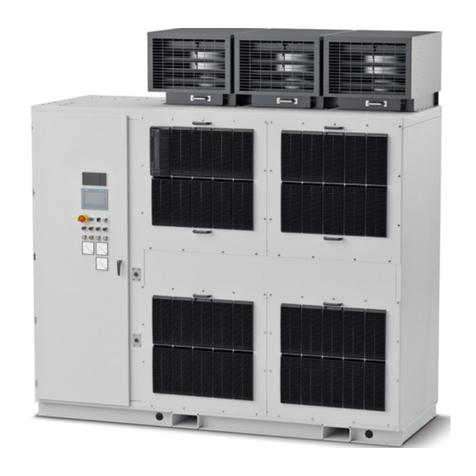
Siemens
Siemens SINAMICS PERFECT HARMONY GH180 operating instructions
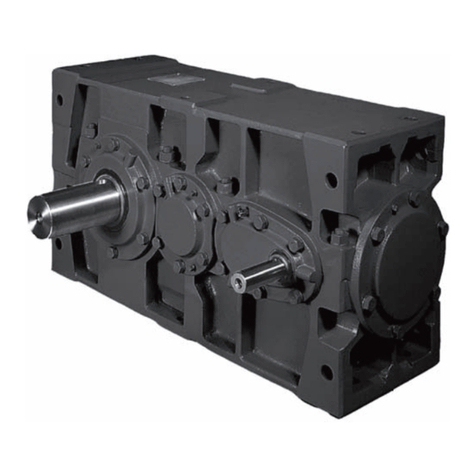
Sumitomo Drive Technologies
Sumitomo Drive Technologies PARAMAX M Series Maintenance manual

Stanley
Stanley PD45 user manual

ABB
ABB ACS 400V instructions
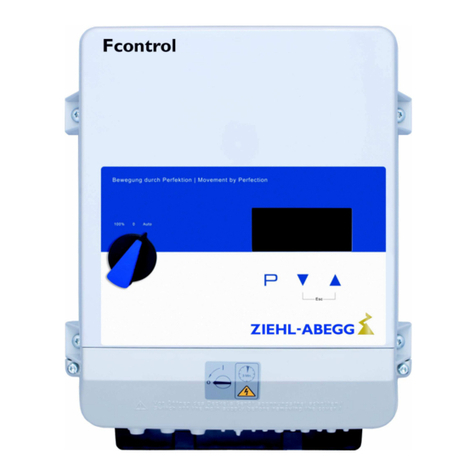
ZIEHL-ABEGG
ZIEHL-ABEGG Fcontrol FTET4AHMQ operating instructions

Becker
Becker U 5.40 operating instructions

